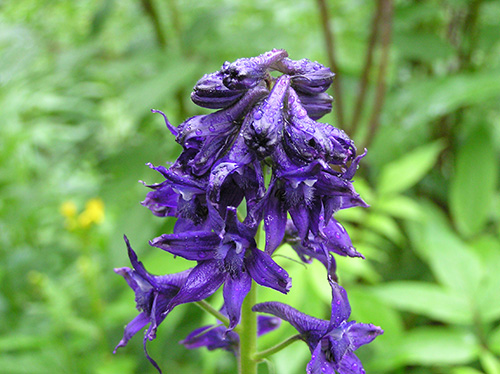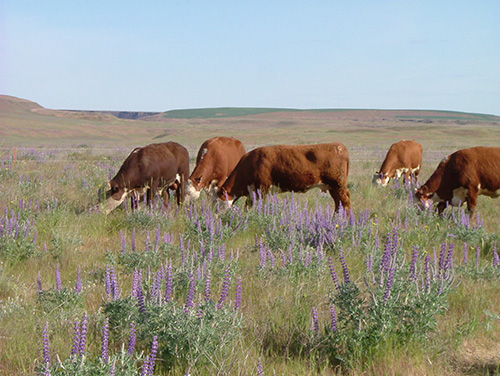
Protecting Our Livestock From Poisonous Plants
 |
Daniel Cook is the research leader of the Poisonous Plant Research Laboratory in Logan, UT where ARS researchers investigate poisonous plants and their toxins and develop management strategies and treatments for ranchers to reduce livestock losses. |
We’re used to thinking of plants as food, or as something that provides us with benefits like fuel or fiber. But some plants have also developed defenses that make them poisonous. As ARS is protecting and developing the plants that nourish us, it also provides solutions to protect our livestock from plants that pose a danger.
Welcome Dr. Cook to Under the Microscope.
UM: Why have some plants evolved to be poisonous, while others can serve as food?
DC: Plants produce an array of secondary compounds, some of which are beneficial, and others that may be poisonous. Scientists believe that plants produce some of these compounds as attractants that may influence pollination, or as a defense mechanism to deter herbivory (being eaten by animals). Cattle and sheep did not co-evolve with these plants, so often the attractiveness and/or deterrence of these plants is related to other herbivores, such as insects or small mammals.
All plants are potentially poisonous to livestock. Paracelsus, a Swiss physician from the 16th century, stated that, “All substances are poisons…the right dose differentiates a poison from a remedy.” Some poisonous plants act quickly, while others may cause long-term problems. For example, the underground tuber of water hemlock (Cicuta) is acutely toxic, while, for locoweeds, Astragalus and Oxytropis species that contain the toxic alkaloid swainsonine, livestock have to consume 10-20% of their diet daily for 2-3 weeks before the onset of any symptoms. Yet other poisonous plants may leave the animal that eats them unharmed, but cause birth defects in the developing fetus.
UM: What leads animals to eat something poisonous?
DC: Grazing livestock select plants to meet their requirements for nutrition and based upon their grazing preferences. In essence, livestock choose to eat plants that taste good to them, just like us. Plants may differ in their palatability based upon the age/seasonality of the plant, and as the plant changes, concentrations of plant secondary compounds change. Some poisonous plants are highly palatable (taste good) while other plants are not as palatable to livestock. For example, grazing cattle choose to eat larkspur (Delphinium) willingly. In contrast, houndstongue (Cynoglossum) is considered unpalatable and generally not grazed by livestock under normal conditions. If an animal becomes hungry enough, they may choose to eat plants that are not palatable.
 Larkspur (Delphinium barbeyi) can poison unwitting, hungry livestock.
Larkspur (Delphinium barbeyi) can poison unwitting, hungry livestock.
UM: Do different plants affect animals in different ways? For instance, could the same plant be poisonous to a cow, a dog, and a human?
DC: Yes and no. Poisonous plants can affect different livestock species in different ways. For example, larkspur (Delphinium) is highly toxic to cattle, but generally not toxic to sheep. Other poisonous plants such as death camas (Zigadenus) are reported to be toxic to all livestock species as well as humans. Pets can be susceptible to many poisonous plants as well, so pet owners should be aware of what plants are in their home and yard.
UM: Does what an animal eats affect humans who later eat the animal?
DC: In theory, yes, a human could be poisoned by eating contaminated products from animals that have been poisoned by plants. Historically this has happened, especially drinking contaminated milk from poisoned cows. However, fortunately, beef and milk production in the United States today is highly managed. Typically beef production involves an animal spending 3-6 months at a feed lot before the animal is harvested. This period would provide more than enough time for any toxins eaten on rangelands to be eliminated. Consideration should be given to the diet of grass-fattened animals that are locally raised and harvested without any time in a feed lot.
UM: Can poisonous plants grow among human food crops and get mixed with them?
DC: Poisonous plants can grow among food crops and may contaminate animal and human foods. Human food crops can be poisonous as well. For some plants, we only eat certain parts of the plant as other parts can be toxic, as in the case of potatoes. Poorly prepared or stored foods can be toxic too – again, think of the potato.
Additionally, the seeds of some poisonous plants may be co-harvested with grain crops, which may contaminate food made from the grain. For example, certain species of plants (e.g., Senecio species) that contain pyrrolizidine alkaloids, known hepatotoxins (affecting the liver), have been found to contaminate grain crops in developing countries.
 Cattle on a lupine grazing study in Ritzville, WA
Cattle on a lupine grazing study in Ritzville, WA
UM: How common are poisonous plants on grazing lands in the United States? How do you help ranchers protect their animals?
DC: Poisonous plants are very common on rangelands within the United States. The number and the species of toxic plants present is highly dependent on composition of the local plant community. The majority of poisonous plants that cause problems in the United States occur on western rangelands as the pastures are unimproved. Most are native species. Some ornamental plants that people plant in landscaping may also be toxic to livestock.
We have a publication concerning common poisonous plants to livestock in the Western United States, available as a printed pamphlet, electronically as a pdf, and more recently as a smart phone app available on the App Store and Google Play Store.
UM: Will climate change affect poisonous plants and their relationship to livestock? If so, how?
DC: Changes in precipitation pattern have been shown to influence the population density of certain toxic plants. For example, some larkspur species as well as some locoweeds are highly responsive to late winter and early spring precipitation. The density of these plants in turn may influence the relative risk to grazing livestock.
Additionally, climate change may influence the abundance and thus relative palatability of other available forage. For example, in dry years, desirable forages such as grasses may be less abundant or senesce sooner while other forages such as lupines may remain green longer, thus becoming more palatable and posing a greater risk to grazing livestock. Although studies are limited, it is highly likely that changing climate and localized weather changes will also influence the concentrations of plant secondary compounds, thus altering the risk of poisoning to grazing livestock.
UM: What are some of your current research initiatives to help reduce livestock poisoning?
DC: Recently, we determined that certain matrices such as ear wax and hair could be used to determine if an animal may have ingested a particular plant. The advantage of hair and/or ear wax is they are less invasive than other matrices (e.g., rumen and blood samples). Currently, we are investigating the potential of some materials to bind toxins within the rumen of cattle. We are also investigating novel diagnostic methods to determine what plants may be in the stomach contents of a poisoned animal.
UM: Are there cures once an animal has been poisoned, or only preventive measures?
DC: In general, there are very few antidotes for livestock. If the ingestion does not cause mortality, the best cure is often the passage of time, which will allow the animal time to eliminate the toxin. In general, we provide management recommendations or preventative measures to livestock producers to reduce their losses due to poisonous plants. For example, these recommendations may include changes in grazing patterns to avoid the toxic plant, changes in breeding dates, and/or application of herbicides to reduce toxic plant abundance. Additionally, we help with diagnostic investigations, we try to answer, “was a poisonous plant responsible for the deaths of these livestock?”
UM: Do poisonous plants ever have positive uses?
DC: Yes, they can. The bioactive compounds in poisonous plants have the potential to be utilized for beneficial medicinal purposes due to their molecular target sites. For example, the bioactive compound cyclopamine, which is responsible for the birth defects caused by Veratrum eaten by pregnant sheep, has been chemically modified and is currently being used as a chemotherapeutic for certain types of cancer.
